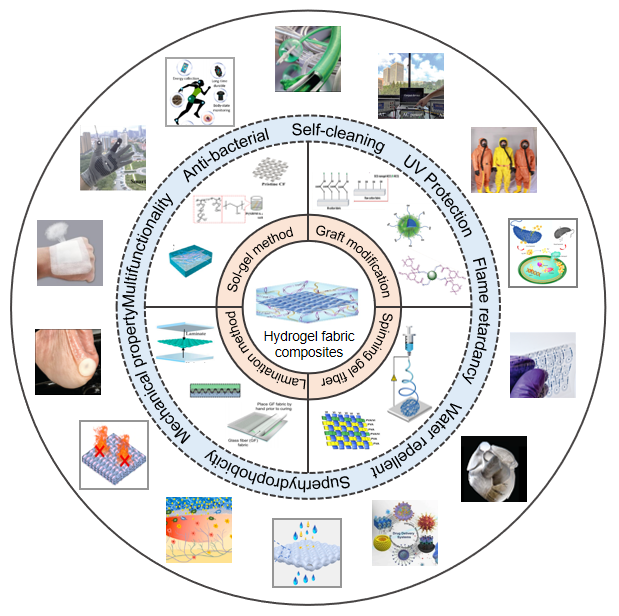 PDF(27514 KB)
PDF(27514 KB)


Hydrogel-Based Textile Composites
Wanru Guo, Zheng Li, Bing Liu, Jixian Gong, Songnan Zhang, Guobao Zheng
Prog Chem ›› 2024, Vol. 36 ›› Issue (6) : 914-927.
 PDF(27514 KB)
PDF(27514 KB)
 PDF(27514 KB)
PDF(27514 KB)
Hydrogel-Based Textile Composites
Hydrogel materials are widely used due to their excellent hydrophilicity,biocompatibility,adjustable biomimetic properties,etc.However,their inherent non-uniform microstructure and low-density molecular chains make their mechanical properties poor,which limits their practical applications.the preparation of hydrogel materials with high mechanical strength yet toughness has been a challenge for research in This field.As composites are constantly developing in the direction of functionalization and intelligence,the introduction of polymer hydrogels into the textile field for the preparation of gel-based textile composites not only improves the defects of gel materials,but also gives textiles excellent properties and broadens their potential application prospects.this paper reviews the research progress of hydrogel textile composites,focusing on the design strategy of hydrogel-based textile composites and their enhanced mechanical and antimicrobial properties,discusses the application progress of the composites in the fields of oil-water separation,medical dressings,wearable electronic devices,and flame-retardant protection,and the future research direction is also prospected.
1 Introduction
2 Methods to prepare hydrogel textile composites
2.1 Sol-gelatinization
2.2 Graft modification treatment
2.3 Lamination
2.4 Hydrogel fiber weaving method
3 Application of hydrogel textile composites
3.1 Oil-water separation
3.2 Medical Dressings
3.3 Wearable electronic devices
3.4 Flame retardant protective products
3.5 Others
4 Conclusion and outlook

hydrogel textiles / composite material / surface modification
| [1] |
|
| [2] |
|
| [3] |
(于秋灵, 李政, 窦春妍, 赵义平, 巩继贤, 张健飞. 化学进展, 2020, 32(2):179.).
|
| [4] |
|
| [5] |
|
| [6] |
|
| [7] |
|
| [8] |
|
| [9] |
|
| [10] |
|
| [11] |
|
| [12] |
|
| [13] |
|
| [14] |
|
| [15] |
|
| [16] |
(崔烨璇, 仝雅娜, 刘伟东, 李政, 巩继贤, 乔长晟. 材料工程, 2023, 51 (09):37.)
|
| [17] |
|
| [18] |
|
| [19] |
|
| [20] |
|
| [21] |
|
| [22] |
|
| [23] |
|
| [24] |
|
| [25] |
|
| [26] |
|
| [27] |
|
| [28] |
|
| [29] |
|
| [30] |
|
| [31] |
|
| [32] |
|
| [33] |
|
| [34] |
|
| [35] |
|
| [36] |
|
| [37] |
|
| [38] |
|
| [39] |
|
| [40] |
|
| [41] |
|
| [42] |
|
| [43] |
|
| [44] |
|
| [45] |
|
| [46] |
|
| [47] |
|
| [48] |
|
| [49] |
|
| [50] |
|
| [51] |
|
| [52] |
|
| [53] |
|
| [54] |
|
| [55] |
|
| [56] |
|
| [57] |
|
| [58] |
|
| [59] |
|
| [60] |
|
| [61] |
|
| [62] |
|
| [63] |
|
| [64] |
|
| [65] |
|
| [66] |
|
| [67] |
|
| [68] |
|
| [69] |
|
| [70] |
|
| [71] |
|
| [72] |
|
| [73] |
|
| [74] |
|
| [75] |
(杨宇州, 李政, 黄艳凤, 巩继贤, 乔长晟, 张健飞. 化学进展, 2021, 33(05):726.).
|
| [76] |
(窦春妍, 李政, 何贵东, 巩继贤, 刘秀明, 张健飞. 化学进展, 2018, 30(8):1161.).
|
| [77] |
|
| [78] |
|
| [79] |
|
| [80] |
|
| [81] |
|
| [82] |
|
| [83] |
|
| [84] |
|
| [85] |
|
| [86] |
|
| [87] |
|
| [88] |
|
| [89] |
|
| [90] |
|
| [91] |
|
| [92] |
|
| [93] |
|
| [94] |
|
| [95] |
|
| [96] |
|
| [97] |
|
| [98] |
|
| [99] |
|
| [100] |
|
| [101] |
|
| [102] |
|
| [103] |
|
| [104] |
|
| [105] |
|
/
| 〈 |
|
〉 |